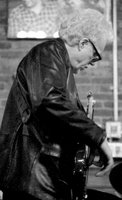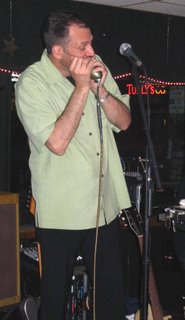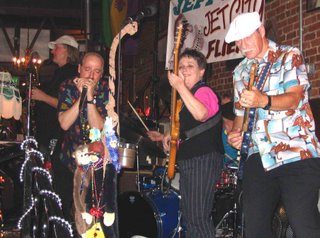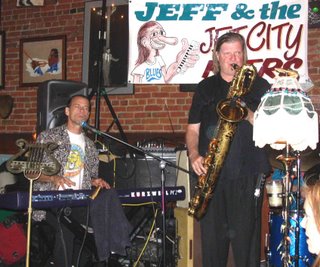Here are some year-end shows that I think will be of interest to Jet City Blues readers. Keep these shows on your radar screens!
1. The Fourth Annual Seattle Superharp Showcase
Seattle's Harmonica Playboy & the Midnight Movers will host this annual Blues Harp extravaganza at the New Orleans Creole Restaurant in Pioneer Square. This year, two blues harp maestros (LynnAnn Hyde and Johnnie Ward) from Portland, Oregon will be featured. Here's the talent lineup:
 Friday:
Friday:Mike "Harmonica Playboy" Lynch
Sheldon Ziro (Bent Reed & Company)
Dave Prez (The Combo Nation)
Johnnie Ward (left - The Bond Street Blues Band)
 Saturday:
Saturday:Mike "Harmonica Playboy" Lynch
Bubba "The Unreal" McCoy (The Broomdust Blues Band)
Bian Lee (The Blues Orbiters)
LynnAnn Hyde (left - Kinzel & Hyde)
Where: The New Orleans Creole Restaurant - 114 1st Avenue South, Seattle, WA (206-622-2563)
When: October 6-7, 2006. Showtime is 9:00 PM.
Cover: $10.00
2. The West Coast Rhythm & Blues Summit
For two nights, October 27th and 28th, 2006, The Highway 99 Blues Club in Seattle will become the scene of what amounts to a classic Rhythm & Blues revue.
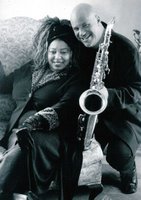 This will be a triple bill, starring Johnny Nocturne (John Firmin - left, with Miss Dee), who the San Francisco Jazz Festival called “The Big Daddy of retro jump-blues tenor saxophone." The show will also star Miss Dee, long time vocalist with the legendary Johnny Otis Show. Miss Dee is the vocalist on the Johnny Nocturne Band CD “Blues Volume”. This portion of the show will also highlight Nocturne keyboard man, Henry Salvia.
This will be a triple bill, starring Johnny Nocturne (John Firmin - left, with Miss Dee), who the San Francisco Jazz Festival called “The Big Daddy of retro jump-blues tenor saxophone." The show will also star Miss Dee, long time vocalist with the legendary Johnny Otis Show. Miss Dee is the vocalist on the Johnny Nocturne Band CD “Blues Volume”. This portion of the show will also highlight Nocturne keyboard man, Henry Salvia.The R&B Summit also includes The Crossroads Band, the Washington Blues Society’s “Best Band” of 2005. Crossroads is a five piece group of seasoned veterans. The Tacoma Weekly said about the band’s new CD: “In case you have never seen them play yet, this record makes you want to change this fact as fast as you can.” Special guests are The Three J’s Alaska reunion band, consisting of John Firmin (aka Johnny Nocturne), John Stephan (John Stephan Band), and John Lee (The Crossroads Band). Describing the Three J’s self-titled CD, Misty Blue, the Canadian radio show host, said “ Alaska sure can rock the blues!” Henry Salvia who plays on the 3J’s CD, joins the band.
Master of Ceremonies for the show will be Rock and Roll Hall of Fame disc jockey, Jimmy “Early” Byrd. “Early” Byrd is the first African-American disc jockey elected to the Hall. The other DJ’s in the Hall of Fame are Alan Freed, Wolfman Jack and Dick Clark.
Where: The Highway 99 Blues Club - 1414 Alaskan Way , Seattle, WA (206-517-7864)
When: Friday October 27th and Saturday October 28th 2006. Showtime is 8:45pm.
Cover: $15.00
For additional information call Mr. Solid Productions at 206-517-7864
3. Beale Street or Bust Fundraiser
This is the second in a series of fundraisers to send the 2006 Washington Blues Society's Best Band, Becki Sue & Her Big Rockin' Daddies to Memphis to compete in the International Blues Challenge in February 2007. Becki Sue & Her Big Rockin' Daddies will perform at this event, as will members of the Hudson Blues Band, Harmonica Playboy & the Midnight Movers, and the Crossroads Band. Also scheduled to appear are blues harp ace Dave Prez and guitarist Alice
Stuart. Three Fender Squire Stratocaster guitars will be raffled off to some lucky fans. Stay tuned for more details on this show.
 Becki-Sue & Her Big Rockin' Daddies
Becki-Sue & Her Big Rockin' DaddiesWhere: The Highway 99 Blues Club - 1414 Alaskan Way, Seattle, WA (206-382-2171)
When: November 12, 2006. Late afternoon to about 10:00 PM (times to be confirmed)
Suggested donation at the door: $10.00
4. Highway 99 Road Rage!!
Harmonica Playboy & the Midnight Movers Vs. Chris Stevens' Surf Monkeys
Recently, the Playboy backed his '77 Coupe DeVille into Chris Stevens' '41 Woody. The damages will be settled out of court with a Battle of the Bands at the Highway 99 Blues club on November 17th. Seattle's 10 most dangerous blues musicians will converge for some Rollin' and Tumblin' under the viaduct. Three guitars, two saxes, 12 harps, and a pair of dynamite rhythm sections will be Ballin' the Jack and Snatchin' it Back! Load Link Wray's "Rumble" into your CD player as you cruise down to the Highway 99 to re-live the glory days of live blues in Seattle with two great bands highlighting one great show!
Seattle's 10 most dangerous blues musicians will converge for some Rollin' and Tumblin' under the viaduct. Three guitars, two saxes, 12 harps, and a pair of dynamite rhythm sections will be Ballin' the Jack and Snatchin' it Back! Load Link Wray's "Rumble" into your CD player as you cruise down to the Highway 99 to re-live the glory days of live blues in Seattle with two great bands highlighting one great show!
Harmonica Playboy (left - photo by Phil Chesnut) & the Midnight Movers:
Mike Lynch (harp/vocals), Tim Sherman and Steve Yonck (guitars), Kirk Tuttle (drums), and Patty Mey (bass). Chris Stevens' (left - photo by Ronda Lee) Surf Monkeys:
Chris Stevens' (left - photo by Ronda Lee) Surf Monkeys:
Chris Stevens (guitar), Les Clinkingbeard and Brian Kent (saxes), Mark Dalton (bass), and Alan Isaacson (drums)
Where: The Highway 99 Blues Club - 1414 Alaskan Way, Seattle, WA (206-382-2171)
When: November 17, 2006. Showtime is 8:30 PM.
Cover: $12.00
5. Second Annual West Coast Guitar killers Showcase Guitarist Tim Sherman will be hosting the Second Annual West Coast Guitar killers Showcase at the Highway 99 Blues Club on November 24th. The featured guitarists this year will include Tim Sherman (The Midnight Movers), Tom Boyle (Becki Sue & Her Big Rockin' Daddies), Chris Stevens (Surf Monkeys), and a rare appearance by David Brewer (left - The Intimidators). The backup band will include Kirk Tuttle (drums), Mark Dalton (bass), and Ron Weinstein (Hammond B-3).
Guitarist Tim Sherman will be hosting the Second Annual West Coast Guitar killers Showcase at the Highway 99 Blues Club on November 24th. The featured guitarists this year will include Tim Sherman (The Midnight Movers), Tom Boyle (Becki Sue & Her Big Rockin' Daddies), Chris Stevens (Surf Monkeys), and a rare appearance by David Brewer (left - The Intimidators). The backup band will include Kirk Tuttle (drums), Mark Dalton (bass), and Ron Weinstein (Hammond B-3).
Where: The Highway 99 Blues Club - 1414 Alaskan Way, Seattle, WA (206-382-2171)
When: November 24, 2006. Showtime is 8:30 PM.
Cover: $12.00


